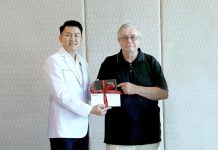Christmas brings me to Christmas Disease, which has nothing to do with Christianity, Santa, mangers, three wise men, virgins or a bottle of myrrh. But it has everything to do with Stephen. And not St. Stephen but Stephen Christmas, that is.
Stephen, a young British lad, was the first patient with a bleeding tendency recognized to have a different form from “classical” hemophilia (or haemophilia if you come from the right hand side of the Atlantic Ocean).
His condition was studied by researchers Biggs, Douglas, and Macfarlane in 1952, who discovered that young Stephen was missing a different coagulation factor than the more usual one (which is known as Factor VIII). They named Stephen’s missing factor as Factor IX, and his condition became known as Christmas Disease.
Just to confuse the issue, we also call Christmas Disease by other names, including Factor IX deficiency, hemophilia II, hemophilia B, hemophiloid state C, hereditary plasma thromboplastin component deficiency, plasma thromboplastin component deficiency, and plasma thromboplastin factor-B deficiency. There’s probably more, but Christmas Disease has a much nicer “ring” to it. (Probably “Jingle Bells” at this time of year!)
From the diagnostic viewpoint, it is very difficult to differentiate between classical hemophilia and Christmas Disease. The symptoms are the same, with excessive bleeding seen by recurrent nosebleeds, bruising, spontaneous bleeding, bleeding into joints and associated pain and swelling, gastrointestinal tract and urinary tract hemorrhage producing blood in the urine or stool, prolonged bleeding from cuts, tooth extraction, and surgery and excessive bleeding following circumcision.
Christmas Disease covers around one in seven cases of the total hemophilia incidence and is around 1/30,000 in the general population. This disease is also male dominated, being called a sex-linked recessive trait passed on by female carriers. This means the bleeding disorder is carried on the X chromosome. Males being of XY make-up will have the disease if the X they inherit has the gene. Females, who have XX chromosomes, are carriers if either X has the bleeding gene.
Hemophilia has been noted in history for many years, and Jewish texts of the second century A.D. refer to boys who bled to death after circumcision, and the Arab physician Albucasis (1013-1106) also described males in one family dying after minor injuries.
In more recent history, royal watchers know that Queen Victoria of Britain’s son Leopold had hemophilia, and that two of her daughters, Alice and Beatrice, were carriers of the gene. Through them, hemophilia was passed to the royal families in Spain and Russia, leading to one of the most famous young men with the disease, Tsar Nicholas II’s only son Alexei.
In the 1800’s physicians thought that the bleeding occurred because of a structural problem in blood vessels. In 1937 a substance was found in normal blood that would make hemophilic blood clot, which was named “anti-hemophilic globulin.”
In 1944 researchers found in one case that when the blood from two different hemophiliacs was mixed, both were able to clot. Nobody could explain this until 1952, when the researchers in England realized there were two types of hemophilia. They called his version hemophilia B, or “Christmas disease,” and the more prevalent kind hemophilia A, or “classic hemophilia.”
With the discovery of A and B types came the realization that there must be different types of “anti-hemophilic globulin” involved in the clotting process. Names were assigned to these various “coagulation factors” by an international committee in 1962. Hemophilia A is a deficiency of Factor VIII, and hemophilia B is a deficiency of Factor IX.
Once it became clear that hemophilia was caused by a deficiency of a coagulation factor, replacement of the missing factor became the method of treatment. In the early 1950’s animal plasma was used. By the 1970’s, coagulation factor concentrates made from human plasma were available, and by the 1980’s we could guarantee that it was HIV free. It has been a long road since Stephen Christmas.
Last minute reminder!
The 50 percent discount for check-up packages at Bangkok Hospital Pattaya have to be paid for by December 31. You can delay having the test up till February 28 2015.




